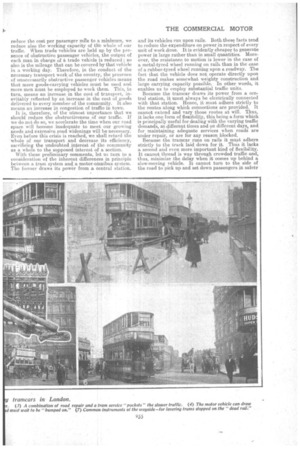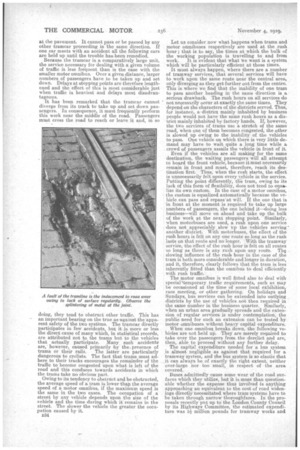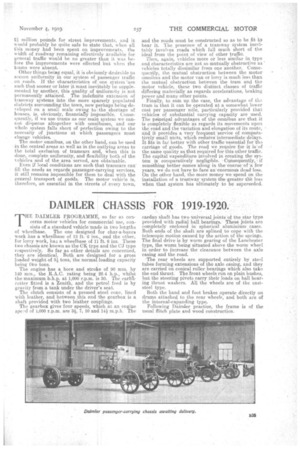TOWN PASSENGER TRAFFIC.
Page 10

Page 11

Page 12

Page 13

If you've noticed an error in this article please click here to report it so we can fix it.
Outstanding Importance of Flexibility in Any System Which.Works Upon the Roads
"Fixed line traffic in streets is doomed."—The Times, October 27th. 1919.
THE QUOTATION which is used as a text for this article is one which, being taken from a great daily paper not actuated by any partisan motives in its consideration of a matter of this kind, is, highly significant and to many readers may be considered somewhat astonishing.
It is only astonishing so long as we take the bald statement alone and without any full appreciation of the arguments that have led to the formation of the opinion which is expressed. Most of us are familiar with the fact that, as regards cost of operation per passenger mile, the tram with its accommodation for 70 or more passengers has the advantage over the familiar type of motorbus capable of carrying only about half this number. If the only thing we had to consider was the reduction to a minimum of the cost of conveyance of the individual, the case for the tram would be an extraordinarily strong one. It is when we realize that there are many other considerations to be taken into account that we begin to appreciate the strength' of the case for the motor oranibus. Public services are provided for the benefit of the public as a whole and., at any given moment, only a comparatively small percentage of the public is carried upon the vehicles provided. It is not our duty to consider only this small percentage. At one time or another most of us are temporarily passengers, but it is not to our ultimate benefit that our interest at these particular times should alone be considered, if the consequence is distinctly to our detriment at all other times.
An obstructive system of vehicles occupying the roads constitutes an immense charge upon the community. The quality of obstructiveness leads to the slowing up not only of these vehicles themselves but of all other traffic. The average speed attained by the obstructive vehicle is lower than that attained by the flexible vehicle. Consequently, if the passenger's time is worth money, the trifling saving in the cost of conveying him may well be more than counterbalanced by the time. loss incurred.
Meanwhile, in our somewhat unbalanced effort to reduce the cost per passenger mile to a minimum, we reduce also the working capacity of the whole of our traffic. When trade vehicles are held up by the presence of obstructive passenger vehicles, the output of each man in charge of a trade vehicle is reduced ; so also is the mileage that can be covered by that vehicle in a working day. Therefore, in the conduct of the necessary transport work of the country, the presence of unnecessarily obstructive passenger vehicles means that more goods-carrying vehicles must be used and more men must be employed to work them.. This, in turn, means an increase in the cost of transport, inevitably reflected by an increase in the cost of goods delivered to every member of the community. It also means an increase in congestion of traffic in town.
it is, therefore, of the utmost importance that we should reduce the obstructiveness of our traffic. If we do not do so, we accelerate the time when our road space will become inadequate to meet our growing needs and extensive road widenings will be necessary. Even before this crisis is reached, we shall retard the whole of our transport and decrease its efficiency, sacrificing the undoubted .interest of the community as a whole to the supposed interest of a section. -With these preliminary eomments, let us turn to a consideration of the inherent differences in principle between a tram system and a motor-omnibus system. The former draws its power from a central station. and its vehicles run upon rails. Both.these facts tend to reduce the expenditure on power in respect of every unit of work done. It is evidently cheaper to generate power in large rather than in small quantities. Moreover, the resistance to motion is lower in the case of metal-tyred wheel running on rails than in the case of a rubber-tyred wheel running upon a roadway. The fact that the vehicle does not operate directly upon the road makes somewhat weighty construction and large carrying capacity possible. In other words, it enables us to employ substantial traffic units.
Because the tramcar draws its power from a central station, it must always be electrically connected with that station. Hence, it must adhere strictly to the routes along which connections are provided. It cannot extend and vary those routes at will. Thus, it lacks one form of flexibility, this being a form which is principally useful for dealing with the varying tsaffic demands, at different times and on different days, and for maintaining adequate services when roads are under repair, or are for any reason blocked. Because the tramcar runs on rails it must adhere strictly to the track laid down for it. Thus it lacks a seoond and even more important kind of flexibility. It cannot thread is way through crowded traffic and, thus, minimize the delay when it comes up behind a slow-moving vehicle. It cannot turn to the side of the road to pick up and set down passengers in safety at the pavement. It cannot pass or be passed by any other tramcar proceeding in the same direction. If one car meets with an accident all the following cars are held up until the trouble has-been remedied.
Because the tramcar is a comparatively large unit, the service necessary for dealing with a given volume of traffic is less frequent than is the case with the smaller motor omnibus. Over a given distance, larger numbers of passengers have to be taken up and set down. Delays at stopping points are therefore lengthened and the effect of this is most considerable just when traffic is heaviest and delays most disadvantageous.
It has been remarked that the tramcar cannot diverge from its track to take up and set down passengers. In consequence, it must frequently perform this work near the middle of the road. Passengers must cross the road to reach or leave it and, in so doing, they tend to obstruct other traffic. This has an important bearing on the true as against the apparent safety of the two systems. The tramcar directly participates in few accidents, but it is more or less the direct cause of many which, in statistical records, are attributed not to the trams but to the vehicles that actually participate. Many such accidents are, however, caused primarily by the. presence of trains or their rails. The latter are particularly dangerous to cyclists. The fact that trams must adhere to their tracks encourages the remainder of the traffic to become congested upon what is left of the road and this conduces towards accidents in which the trams take no obvious part. Owing to its tendency to obstruct and be obstructed, the average speed of a tram is lower than the average speed of a motor omnibus, if the maximum speed is the same in the two cases. The occupation of a street by any vehicle depends upon the size of the stehicle and the time during which it remains in the street. The slower the vehicle the greater the occupation caused by it. 134 Let us consider now what happens when trams and motor omnibuses respectively are used at the rush hour ; that is to say, the times at which the bulk of the working population is travelling to and from work. It is evident that what we want is a system. which will be particularly efficient at those times.
It must always happen, where there are a number of tramway services, that several services will have to work upon the same route near the central area, only diverging as they get further out from the centre. This is where we find that the inability of one tram to pass another heading in the same direction is a serious drawback. The rush hours on all services do not necessarily occur at exactly the same times. They depend on the characters of the districts served. Thus, for instance, a-district mainly inhabited by business people would not have the same rush hours as a district mainly inhabited by factory hands. If, however, the two services of trams use a stretch of the same road, when one of them becomes congested, the other is slowed up Owing to the inability of the vehicles to pass. One vehicle on which there is very little demand may have to wait quite a long time while a crowd of passengers assails the vehicle in front of it.
Even if the vehicles are all making for the same destination, the waiting passengers will all attempt to board the front vehicle, because it must necessarily remain in front and must, therefore, reach its destination first. Thus, when the rush starts, the effect is unnecessarily felt upon every vehicle in the service. Putting the point differently, the tram, owing to its lack of this form of flexibility, does not tend to equalize its own custom. In the ease of a motor omnibus, the custom is equalized automatically because the vehicle can pass and repass'at will. If the one that is in. front at the moment is required to take up large numbers of passengers, the one behind it—doing less business—will move on ahead and• take up the bulk of the work at the next stopping point. Similarly, when motorbuses are used, a rush upon one service does net appreciably slow lip the vehicles serving another district. With motorbuses, the effect of the rush hours is felt on any one route so long as the rush lasts on that route and no longer. With the tramway service, the effect. of the rush hour is felt on all routes so long as there is any rush upon any route. The slowing influence of the rushhour in the case of the tram is both more considerable and longer in duration, and it, therefore, clearly follows that the tram is less inherently 'fitted than the omnibus to deal efficiently with rush traffic.
The motor omnibus is well fitted also to deal with speciaPtemporary traffic requirements, such as may be occasioned at the time of some local exhibition, race meeting, or other gathering. On holidays and Sundays, bus services can be extended into outlying districts by the use of vehicles not then required in the same number in the business quarter. Similarly, when an urban area gradually spreads and the extension of regular services is under contemplation, the public, need for such an extension can be tested by motor omnibuses without heavy capital expenditure.
When one omnibus breaks down, the following vehicles are not held up. They are merely required to take over the passengers from the derelict and are, then, able to proceed without any further delay. The capital expenditure needed for a bus system is almost negligible as against that. required for a tramway system, and the bus system is so elastic that it can always be of exactly the right extent, neither over-large nor too small, in respect of the area covered.
Buses admittedly cause some wear of the road surfaces which they utilize, but it is more than questionable whether the expense thus involved is anything approaching an equivalent to the cost of road widenings directly necessitated where tram systems have to be taken through narrow thoroughfares. In the proposals recently put up to' the London County Council by its Highways Committee, the estimated expenditure was 5k million pounds for tramway works and
21million pounds for street improvements, and it would probably be quite safe to state that, when all this money had been spent on improvements, the width of roadway remaining effectively available for general traffic would be no greater than it was before the improvements were effected but when the n7ams were absent..
Other things being equal, it is obvionsly desirable to secure uniformity in our system of passenger traffic on roads. If the characteristics of one system are such that sooner or later it. must inevitably be supple. mented by another, this quality of uniformity is not permanently attained. The Indefinite extension of tramway systems into the more sparsely populated districts surrounding the town, now perhaps being developed on a small scale owing to. the shortage of houses, is. obviously, financiafly impossible. Consequently, if we use trams as our main system we cannot dispense altogether with omnibuses, and our whole system falls short of -perfection owing to the necessity of junctions at which passengers must change vehicles.
The motor omnibus, on the other hand, can be used in the central areas as well as in the outlying areas to the total exclusion of tramcars and, When this is done, complete uniformity, and flexibility both of the vehicles and of the area served, are obtainable. Even if local conditions are such that tramcars can' fill the needs as regards passenger-carrying services, it still remains impossible for them to deal with the general transport of gocids. The motor vehicle is, therefore, an essential in the streets of every town, and the roads must be constructed so as to be fit to bear it. The presence of a tramway system inevitably involves roads which fall much short of the ideal from the point of view of other traffic. • Then, again, vehicles more or less similar in• type and characteristics are not so mutually obstructive as vehicles totally dissimilar from one 'another. Consequently,. the mutual obstruction between the motor omnibus and the motor van or lorry is much less than the mutual obstruction between the tram and the motor vehicle, these two distinct classes of traffic differing materially as regards accelerations, braking power and many other points.
Finally, to stun up the case, the advantage of the tram is that it can be operated at a somewhat lower cost per passenger mile, particularly provided that vehicles of substantial carrying capacity are used. The principal advantages of the omnibus are that it is completely flexible as regards its movements upon the road and the variation and elongation of its route, and if prbvides. a 'Very frequent service of cornparatively small units, whicIrrednees'intermediate delays. It fits• in far -better with other traffic'essential for the carriage of goods. The road We require for it is nf the same quality as that required for this other traffic. The capital expenditure involved in creating the system ra ComparativelY negligible. Consequently, if something better comes along in-the conrse -of 'a few years,we do not have to face an enormous deadioaa. On the other hand; the more money we-spend on the installation of a traanway-systein the-greater We -loss when that system has ultimately to be superseded.


























